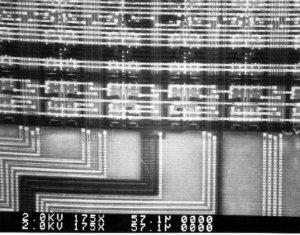Extract MCU PIC18F6410 Eeprom
Extract MCU PIC18F6410’s memory include Eeprom and flash, clone the heximal file to blank Microcontroller to provide the same functions as original Microcontroller;

Extract MCU PIC18F6410’s memory include Eeprom and flash, clone the heximal file to blank Microcontroller to provide the same functions as original Microcontroller
All of the devices in the PIC18F6410 family incorporate a range of features that can significantly reduce power consumption during operation. Key items include:
· Alternate Run Modes: By clocking the controller from the Timer1 source or the internal oscillator block, power consumption during code execution can be reduced by as much as 90%.
· Multiple Idle Modes: The controller can also run with its CPU core disabled, but the peripherals still active. In these states, power consumption can be reduced even further – to as little as 4% of normal operation requirements.
· On-the-Fly Mode Switching: The power managed modes are invoked by user code during operation, allowing the user to incorporate power-saving ideas into their application’s software design.
· Lower Consumption in Key Modules: The power requirements for both Timer1 and the Watchdog Timer have been reduced by up to 80%, with typical values of 1.1 µA and 2.1 µA, respectively.
All of the devices in the PIC18F6410 family offer nine different oscillator options, allowing users a wide range of choices in developing application hardware. These include:
· Four Crystal modes, using crystals or ceramic resonators.
· Two External Clock modes, offering the option of using two pins (oscillator input and a divide-by-4 clock output) or one pin (oscillator input, with the second pin reassigned as general I/O).
· Two External RC Oscillator modes, with the same pin options as the External Clock modes.
· An internal oscillator block which provides an 8 MHz clock (±2% accuracy) and an INTRC source (approximately 31 kHz, stable over temperature and VDD), as well as a range of six user selectable clock frequencies between 125 kHz to 4 MHz for a total of eight clock frequencies. This option frees the two oscillator pins for use as additional general purpose I/O in the process of IC Extracting.
· A Phase Lock Loop (PLL) frequency multiplier, available to both the High-Speed Crystal and Internal Oscillator modes, which allows clock speeds of up to 40 MHz. Used with the internal oscillator, the PLL gives users a complete selection of clock speeds from 31 kHz to 32 MHz
– all without using an external crystal or clock circuit.
Besides its availability as a clock source, the internal oscillator block provides a stable reference source that gives the family additional features for robustoperation:
· Fail-Safe Clock Monitor: This option constantly monitors the main clock source against a reference signal provided by the internal oscillator. If a clock failure occurs, the controller is switched to the internal oscillator block, allowing for continued low-speed operation or a safe application shutdown.
· Two-Speed Start-up: This option allows the internal oscillator to serve as the clock source from Power-on Reset or wake-up from Sleep mode until the primary clock source is available.
Tags: extract mcu protected archive,extract mcu protected code,extract mcu protected content,extract mcu protected data,extract mcu protected eeprom,extract mcu protected file,extract mcu protected firmware,extract mcu protected information,extract mcu protected memory,extract mcu protected program

